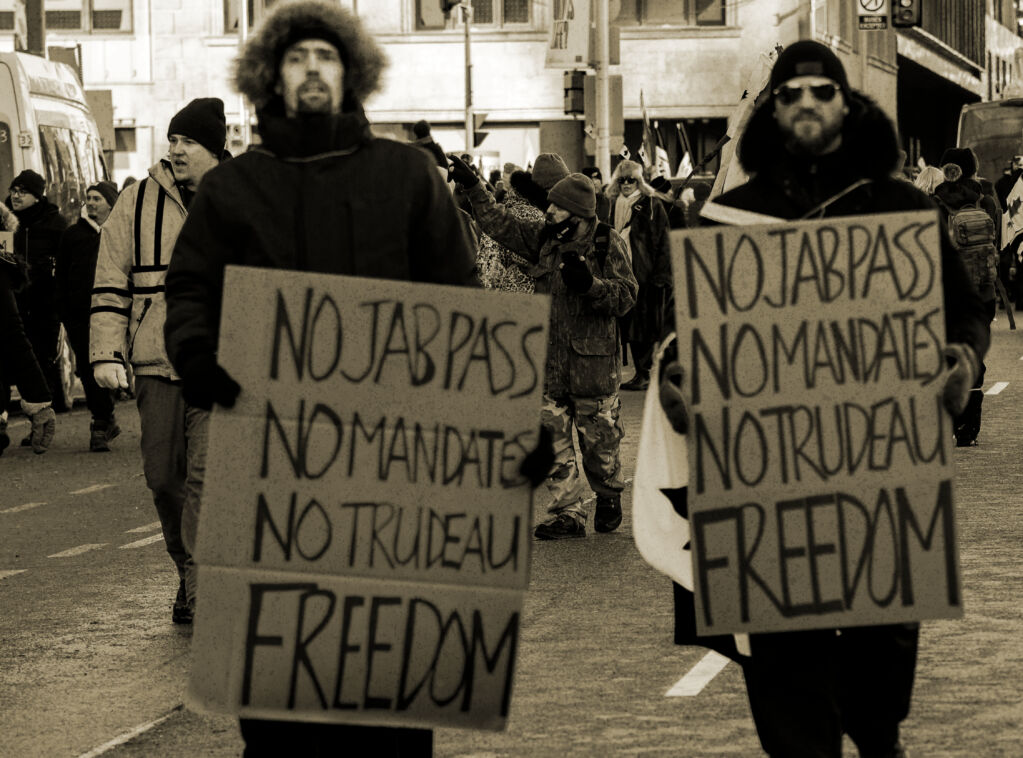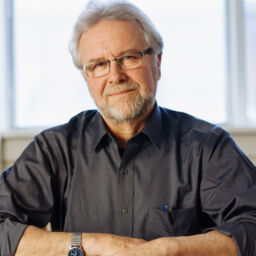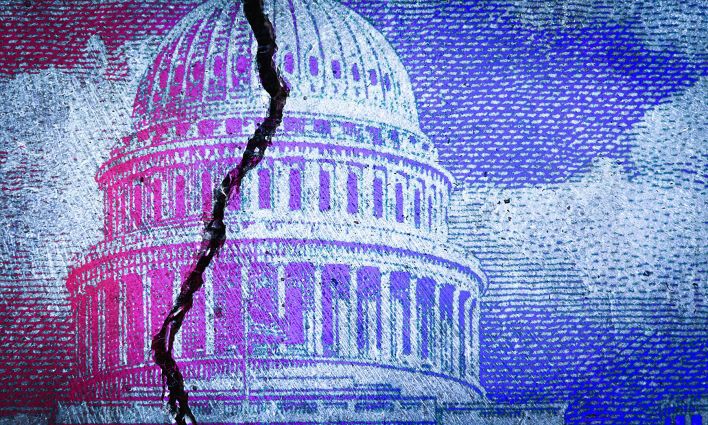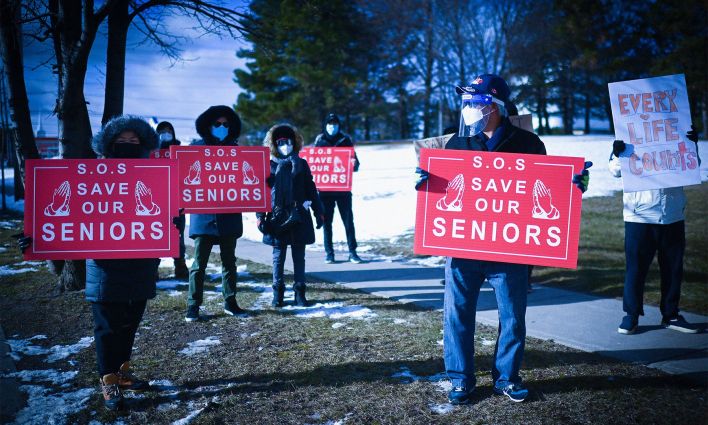In remission for now, the “Freedom Convoy,” led by a small group of well-funded, seditionist and far-right activists, tapped into the grievances of a much larger segment of the population that is resentful of government policies—measures which have triggered anxiety about their ability to earn a living and their future.
EKOS pollster Frank Graves and Munk School senior fellow Michael Valpy’s analysis of the forces behind the convoy highlights the sympathy the convoy has generated from one-third of the Canadian public—disproportionately higher among youth and those who identify as “working class.”
They link this support to a long-held belief by 65% of Canadians that the growing concentration of wealth could result in violent class conflict. The number rises to 78% for those under 35 years old and 81% for those who identify as working class.
In this winter of discontent, there is a correlation between extreme wealth disparities and these protests. It may very well foreshadow an escalating series of violent class conflicts in Canada and abroad.
The power of the super-rich has increased at the same time the working classes have become increasingly marginalized. John Kenneth Galbraith, in his 1979 The Annals of an Abiding Liberal, warned of the impact of ascendant corporate power and declining union density on income and wealth inequality. He described the return of depression-era laissez-faire capitalism—sidelined during the post-Second World War reconstruction—as trickle-down economics, using a metaphor drawn from his early education in economics and animal husbandry at the Ontario Agricultural College: “If one feeds the horse enough oats, some will pass through to the road for the sparrows.”
Waves of privatization, deregulation, tax cuts, corporate concentration and financially-driven corporate globalization—the return of what John Maynard Keynes called the oppressive speculative power of "functionless financial investors”—have validated his prediction of an unprecedented wealth pyramid with corporations and the super-rich at its apex. “Plutocrats” was the term Canadian Finance Minister and Deputy Prime Minister Chrystia Freeland used to describe this cabal in her former life as a journalist.
The World Inequality Report 2022 found the poorest 50% of the world’s population owned just 2% of total wealth, while the richest 10% owned 76% of total wealth. The top 1% has 19 times more wealth than the bottom 50% of humanity—a level of inequality not seen since the beginning of the twentieth century.
During the pandemic, the world’s 10 richest men have doubled their fortunes while the income of 99% of humanity is worse off because of COVID-19, according to Oxfam. Over 160 million people are projected to have been pushed into poverty.
In this winter of discontent, there is a correlation between extreme wealth disparities and these protests. It may very well foreshadow an escalating series of violent class conflicts in Canada and abroad.
Canada is no exception. The poorest 50% of Canadians now hold 6% of total wealth, the top 10% of Canadians hold 58% total wealth, and the richest 1% of Canadians hold 25% of total wealth, according to the World Inequality Report. Canada’s billionaires now have as much wealth as the 12 million poorest Canadians.
Journalist Aaron Wherry recently recalled a speech Prime Minister Justin Trudeau gave in Germany in 2017, wherein he talked about the anxiety and resentment of government due to increasing income and wealth inequality, anticipating it turning to anger.
His government subsequently took important measures to reduce child poverty as well as reduce the cost of child care and post-secondary education. It has provided financial support to workers and businesses affected by the pandemic.
However, apart from a few boutique tax measures, it has done next to nothing to reduce the wealth gap in the five years that followed Trudeau’s speech. There is no wealth tax on the super-rich, no increase in rates for the top income tax bracket, no corporate income tax increase, no increase in the capital gains and dividends tax, no surtax on Canadian billionaires profiteering from the pandemic, no significant penalties on high-carbon-emitting activities, no significant clamping down on tax avoidance and evasion by corporations and the very wealthy via a spider’s web of tax havens. The government’s aversion to imposing an estate tax ensures Canada’s family dynasties can pass down exorbitant amounts of wealth to their descendants well into the future. Even under the most optimistic scenario, the forthcoming federal budget is unlikely to significantly shrink the wealth gap.
All this suggests that sympathy for the convoy is in part a manifestation of Trudeau’s own diagnosis of the consequences of government inaction in reducing wealth inequality. The implication suggested by EKOS polling is that anger and the potential for violent class conflict could well intensify.
The World Inequality Report 2022 also insisted that addressing the climate crisis “is not feasible without significant redistribution of income and wealth inequalities.”
All this suggests that sympathy for the convoy is in part a manifestation of Trudeau’s own diagnosis of the consequences of government inaction in reducing wealth inequality.
The most recent IPCC report identifies inequality as a major determinant of exposure to climate hazards. The richest 10% of the Canadians emit 60.3 tonnes of CO2, per capita, per year; the top 1% emits 190 tonnes, per capita. The poorest 50% of Canadians emit an average of 10 tonnes, per capita, annually.
This is an obvious source of resentment for low- to middle-income Canadians who feel they are being unfairly targeted by government climate policies. Members of the convoy have dismissed what they call the government’s empty promises to provide the funding necessary to ensure they will have a just transition from their dependence on oil and gas.
The emergence of a pyramid of wealth and power that is insistent on maintaining the status quo and is resistant to systemic change, was one factor noted in Ronald Wright’s 2004 Massey Lectures, A Short History of Progress, which explores factors that have led to the collapse of past civilizations.
While Wright was focused on the likelihood of collapse of worldwide civilization due to nuclear war or climate catastrophe, plutocratic inaction on worldwide inequality can only amplify the risks.
Resentment over growing wealth and inequality in Canada unquestionably helped to generate sympathy toward the Convoy insurrection. It stands as a warning sign for Canada and the world that unless those at the top of the wealth and power pyramid recognize the priority of reducing inequality, political instability and violent conflict disrupting international efforts to ward off the climate apocalypse and civilization collapse will fester.
This article appeared in the May/June issue of the Monitor.
Header image photo credit: Michael Swan







